
2024
Advantages:
1. Resilience to Weather: Today’s drones are designed to handle mild rain thanks to advanced weatherproofing, allowing crucial tasks to proceed even in adverse conditions.
2. Crucial in Emergencies: During disasters or critical situations, drones can be indispensable in rain, offering a bird’s-eye view where human access is restricted.
3. Boost for Agriculture: Light rain can improve the accuracy of agricultural drones by minimizing dust in the air, giving clearer data for assessing crop health.
4. Uninterrupted Operations: For industries like construction and infrastructure, rain-resistant drones help avoid delays by continuing operations even during light showers.
---
Drawbacks:
1. Visibility Challenges: Rain can obscure the drone’s camera view, compromising the clarity and precision of the images or data it captures.
2. Water Damage Risk: Wet conditions can result in water seeping into the drone’s components, especially if it's not fully weather-sealed, posing a risk to its electronics.
3. Shortened Battery Life: Wet and windy weather adds resistance, causing the drone’s battery to deplete faster, limiting flight duration.
Final Thoughts: While drones can brave light rain, operators should weigh the risks carefully. Proper weatherproofing and awareness of the elements are key to successful missions in wet conditions.
